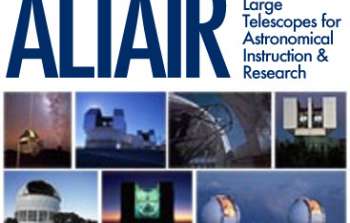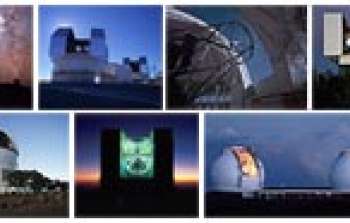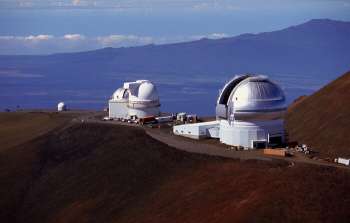sci09006 — Announcement
Results of Survey on Possible New Instrument Start for Gemini
September 30, 2009
In the last issue of Currents, we described the possibility of a new instrument start for Gemini in 2010. This development is an outcome of the Access to Large Telescopes for Astronomical Instruction and Research (ALTAIR) study, which called for an improved Gemini instrumentation suite that is more responsive to the needs of the US Community. In response, the US members of the Gemini Science Committee (GSC) and the Gemini Board have been working with NOAO to create a new instrument start for Gemini on a short time scale.
To provide input to this process, we asked readers to respond to an online survey to help identify the instrument that has the highest priority for a new start. The survey described three new instrument concepts currently being considered by the GSC: an optical echelle (R ~ 40,000), an IR echelle (R ~ 30,000; 1-5 microns), and an intermediate resolution O/IR spectrograph similar to the X-shooter at the VLT (single object; R=4,000-14,000; optical to K-band in one shot). Readers were asked to indicate their highest priority, either from among these capabilities or an instrument they could specify. We also gave readers the opportunity to provide further comments regarding their selection.
We received 246 responses within the two-week survey period, with the IR echelle and the moderate resolution O/IR spectrograph receiving the largest number of endorsements. The table below shows the fraction of respondents that favored each capability among all respondents (246); US-based respondents (208); and US-based respondents that are currently grad students (14), postdocs (56), or in a more senior position (138).
The fraction of respondents who favored a high resolution instrument (optical or IR echelle) was comparable to the fraction favoring the moderate resolution instrument. A similarly significant demand for high resolution spectroscopy was indicated in the ALTAIR survey. The IR echelle was the highest priority among the small number of grad student respondents, while the X-shooter was the most requested among the postdocs who responded. Both the X-shooter and the IR echelle had significant demand among the more senior respondents.
Table 1. Instrument Priorities
| All (246) |
US-based (208) |
Grad Students (14) |
Postdocs (56) |
More Senior (138) |
|
|---|---|---|---|---|---|
| Opt. Echelle | 13% | 14% | 21% | 11% | 14% |
| IR Echelle | 31% | 34% | 50% | 27% | 35% |
| X-shooter | 45% | 43% | 21% | 57% | 40% |
| Other | 10% | 9% | 0% | 5% | 11% |
| None | 1% | 0% | 7% | 0% | 0% |
The comments showed enthusiasm for a new instrument start. One respondent noted that, “It is imperative that Gemini get a quick start on new instrumentation. Whichever instrument is built, it should be a desirable resource that is tradeable for complementary capabilities on other platforms.” Another respondent commented, “The focus on highly capable single-object spectrographs is a wise move, as these are sorely needed, relatively straightforward capabilities that take advantage of Gemini’s aperture while not being hurt by Gemini’s narrow field of view.” Many respondents also took advantage of the comments section of the poll to describe the strategic and science-based arguments behind their stated preferences.
Optical Echelle
Fans of the optical echelle pointed to the limited access that the NOAO open access community has to this resource. One respondent commented, “An optical echelle spectrograph would fill a large gaping hole in current Gemini instrumentation. To my knowledge, no other comparably large optical telescope on the planet has Gemini’s…essential lack of instrumentation for moderate-to-high resolution optical spectroscopy.” Since most optical echelles on large aperture telescopes are located in the northern hemisphere, Gemini South might be preferable over Gemini North for such an instrument.
However, other respondents reasoned that the very fact that there are other effective optical echelles out there on large telescopes made this a less competitive instrument for Gemini, adding that it would be more effective to trade Gemini time for access to such instrumentation on other large telescopes (e.g., Keck/HIRES, Magellan/MIKE). This approach would only be effective if Gemini had a fairly unique, high-demand capability for which other observatories would be interested in trading time.
IR Echelle
Fans of the IR echelle thought that it might be the kind of instrument to enable time trades. They pointed to the near uniqueness of IR echelles on large telescopes (Keck/NIRSPEC, Gemini/Phoenix, VLT/CRIRES) and the broad range of exciting science that they enable. Respondents suggested that an IR echelle would be useful to follow up results from space missions (e.g., WISE, Herschel, JWST). The broad appeal of high resolution infrared spectroscopy is indicated by the results of both the ALTAIR survey and this survey, the popularity of NIRSPEC shown in the proposal statistics for TSIP and NASA Keck time, and for Phoenix on Gemini through the NOAO proposal process. It was also noted that CRIRES is highly oversubscribed at the VLT.
Proponents remarked that an IR echelle makes good use of the IR optimization of Gemini as well as its large aperture, thereby opening a large discovery space. The discovery space might be larger on Gemini North given its relatively colder, drier site. It was further noted that NIRSPEC is aging (more than 10 years old), and advances in detector format and sensitivity offer the opportunity to build a new, more capable instrument. The lack of other current initiatives to build an IR echelle on a large telescope suggests that Gemini could get there first.
X-shooter
Supporters of the X-shooter concept commonly pointed to its flexibility and the broad range of science that it would enable. The anticipated high demand is indicated by the response to the survey. The high oversubscription rates at the VLT for X-shooter itself were also mentioned. The scientific flexibility of the instrument was also raised as an advantage in following up wide-field imaging surveys, in particular time domain studies (Panstarrs, LSST, etc), and results from space missions (WISE, Herschel, JWST). The need for high throughput was stressed by several respondents.
For many respondents, the attraction of the X-shooter was its ability to provide basic optical or NIR spectroscopy. However, a few respondents commented on their specific needs for the broad wavelength coverage (optical through K-band) that an X-shooter on Gemini would provide. These included the study of red or obscured objects (e.g., brown dwarfs and AGN), small solar system bodies, photometric redshifts, and SEDs of galaxies. A few respondents further commented that the broad wavelength coverage could lead to interesting, perhaps serendipitous discoveries.
Next Steps
The results of the survey are being forwarded to the US Science Advisory Committee (SAC) and the US members of the GSC. The results provide valuable input to the GSC, which is currently deliberating on this topic in preparation for its meeting in mid-October. The GSC discussion will provide input to the Gemini Board. We will report on developments on this topic in a future issue of Currents.
About the Announcement
| Id: |
ID
sci09006
|


